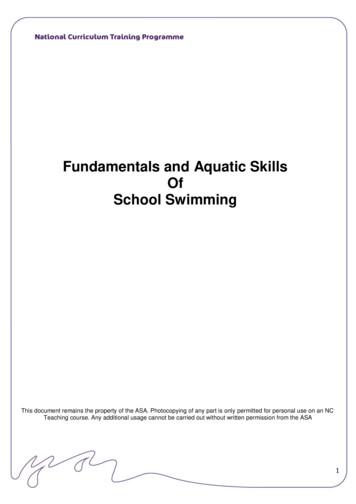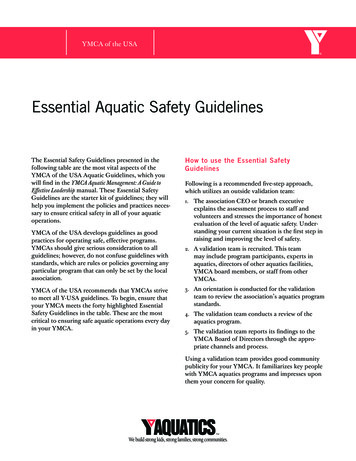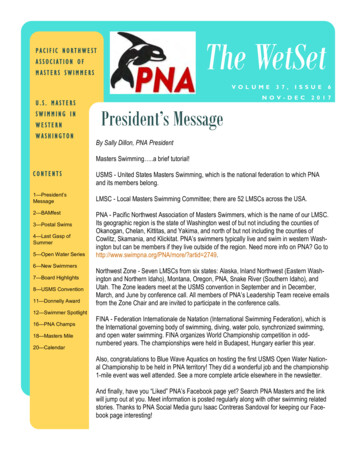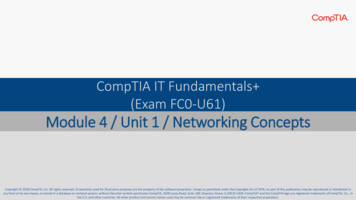
Transcription
Fundamentals and Aquatic SkillsOfSchool SwimmingThis document remains the property of the ASA. Photocopying of any part is only permitted for personal use on an NCTeaching course. Any additional usage cannot be carried out without written permission from the ASA1
TitleAbout the Learner GuideIntroduction to working in a pool environmentHealth and safetyLife-guardingRescue equipmentHygiene and cleanlinessRoles, relationships and responsibilitiesDuty of careQualificationsRisk managementSafeguarding and protecting childrenOrganisation of the working environmentSwimming and water safety in the national curriculumStatutory requirementsWater safetyPractical teaching guidelinesPupil/teacher ratiosEquipmentWorking with non swimmers and beginnersPrinciples of movement in waterFundamentals and aquatic skillsFUNdamentals – Key Underpinning SkillsIntroduction to the four strokesFront CrawlSelected simple practices for introducing front crawlBack CrawlSelected simple practices for introducing back crawlBreaststrokeSelected simple practices for introducing breaststrokeButterflySelected simple practices for introducing butterflyCorrecting aquatic skills – key pointsIntroduction to stroke analysis and stroke improvementEffective CommunicationTeaching methods and related topicsPlanningSchemes of workPlanning an effective school swimming programmePage 86061626264677175772
About this Learner GuideThis Learner Guide has been developed to support candidates undertaking the ASA Certificatefor Teaching School Swimming. It does not cover every aspect that makes up the syllabus forthis certificate and is designed to be used in conjunction with all Modules of the trainingprogramme, or as a self-paced learning tool. In addition, some aspects not covered on thecourse are included for future reference.The Learner Guide will be used to support the taught programme. The exact way in which it willbe used will depend upon your tutor and the particular needs of each candidate. The learnerguide can be used during the course as a means of enabling you to check your understanding.The learner guide can also be used as an ongoing teaching resource to assist you after youhave completed the programme.NOTE: Teachers who intend to complete all modules are expected to retain this learnerguide throughout the course .Disclaimer Clause:Whilst all care has been taken in the development of this resource the Amateur SwimmingAssociation (ASA) takes no responsibility for errors, omissions or inaccuracies. This informationis designed to assist teachers to operate safely, however it cannot identify all possible risks orrisk management strategies and does not purport to provide legal advice. Any legal matters,insurance or liability issues arising from information outlined in this resource should be referredto a solicitor.3
Introduction to Working in a Pool EnvironmentThis section will cover:Health and Safety including Pool Safety Operating Procedures (PSOPs)Roles, Responsibilities and RelationshipsSafeguarding and Protecting ChildrenOrganisation of the Learning EnvironmentSwimming and Water safety in the National CurriculumPractical Teaching GuidelinesEquipment and Swimming AidsHealth and SafetyAll teachers working in a swimming pool environment have the responsibility for the health andsafety of colleagues and pupils. The ultimate responsibility rests with the manager of the poolwho will set certain standards covering all aspects relating to the operation of the facility withinwhich the session takes place. This is, however, very much at the contract level and, inpractice, the responsibility lies with the teacher working on the poolside and in particular, theperson in overall control of the session. Any effective health and safety policy relies upon allparties being familiar with the procedures adopted for the pool in which the teacher is working.A core responsibility of all teachers is to provide their pupils with a safe learning environment inwhich they can develop their skills and achieve their goals. There must be a collectiveresponsibility to safety.The main considerations in any aquatic health and safety policy are: Requirements for life guardingTeaching and coaching qualifications appropriate to the role Requirements relating to Teacher : Pupil RatiosOrganisation and management of the classPool depths in relation to activities being undertakenProcedures for dealing with an incident and accidentAll teachers should ensure that the pool being used has a well-established Normal OperatingProcedure (NOP) and Emergency Action Plan (EAP) collectively known as Pool SafetyOperation Procedures (PSOPs). Pupils should be aware of the implications of these and theactions which they would need to take in the event of any emergency.4
The following check list will provide the basis for safety within the swimming pool. Has the NOP and EAP been read and understood?Is the life guarding requirement being met?Are the teachers plus assistants appropriately qualified to perform the role? Is the number in the group appropriate? Is there sufficient number of teachers, assistants or helpers on the poolside?The Emergency Action Plan (EAP) will provide the basis for dealing with unforeseen difficultiesand problems in the swimming pool. Every teacher working on poolside should be familiar with: The emergency signal The action which the pupils should take in an emergencyThe back up support available from the pool centre staffThe location and use of the life-saving aidsThe procedures for contacting the emergency services The procedure for the recording of accidentsIn addition to an awareness of PSOPs teachers should also be aware of guidelines provided bythe National Governing Body in relation to. Teaching from the poolsideDiving and jumping into shallow waterSafe supervision for teaching and coachingLife-guardingThere is a statutory requirement for a ‘lifeguard’ to be available whenever a school swimminglesson is taking place. Ideally this will be a designated person with an appropriate nationallyrecognised lifeguard qualification. At the very least this should be a designated person trainedto carry out a rescue and to carry out basic life support. The ‘Management of Health and Safetyin the Swimming Pool’ states that in certain circumstances a swimming teacher can also be the‘lifeguard’ for his/her group subject to holding the appropriate qualifications and or training.This only applies to ‘programmed’ swimming.Programmed activity is defined as; with a formal structure disciplined supervised or controlled continuously monitored from the poolside5
The minimum national qualification for the life-guarding of a single group engaged inprogrammed activity is the National Rescue Award for Swimming Teachers and Coaches.Where the lifeguard function is being provided for a whole class the recommended nationalqualification is the RLSS Pool Lifeguard qualification.Rescue EquipmentAlthough the requirements regarding life-guarding can be met in a variety of ways (see 1.1.1)some understanding of the types of rescue equipment commonly found in a swimming poolmay be helpful and all teachers are encouraged to ensure familiarity with that equipment whichis provided in the pool in which they are working. Commonly found pieces of equipment are: Reaching poleThrow bagTorpedo buoy Throwing ropeIn addition, simple equipment such as floats and balls can be used to provide effective supportto anyone who may be in difficulty. One of the main advantages of using this type of equipmentis that the teacher can avoid entering the water to affect a rescue. This not only reduces the riskof the teacher getting into difficulties but also permits a measure of control to be maintainedover the rest of the group.Reaching poleShort reaching poles are particularly useful for weak or non-swimmers in difficulties close to theside. Longer reaching poles are sometimes available but these can be difficult to use inconfined spaces. Regular and frequent practice is required if this type of rescue aid is utilised inthe swimming pool where the teacher is operating.Throw bags, torpedo buoys, throwing ropesThese are non-rigid rescue aids and are increasing used in swimming pools. They areparticularly useful for rescues which are some distance away form the side of the pool and havethe advantage of being able to be used in confined spaces. They do, however, require a degreeof expertise in terms of throwing the aid accurately to the swimmer in difficulties. One majordisadvantage is that if the swimmer in difficulties and is unable to reach the aid which has beenthrown, the rescuer will be required to recoil the rope before having another attempt. As with thereaching pole regular and frequent practice is required to ensure that, if required, the rescuecould be carried out effectively.6
In both cases the rescuer should: Attract the attention of the casualty and give reassurance Keep the casualty under close observationAttain a comfortable secure positionReaching – Keep the centre of gravity as low as possible (lying down or kneeling)Throwing – Avoid standing too close to the edge of the poolReach out or throw the aid and instruct the casualty to hold on to itPull the casualty to safety with a steady movementPool RulesIt is important to establish clear pool rules with the pupils. The rules should not only set astandard for the session but also reinforce good practice whenever they visit the swimming poolIn school swimming safety considerations may be discussed as a classroom activity. If this isthe case it is still important for the teacher to outline procedures again as some pupils may havemissed that classroom session or forgotten elements of it.Some areas a teacher should be addressing in the rules are: Pupils not to enter the water without direct permissionPupils not to leave the class without permission Any whistle code that may be used for signallingThe importance of wearing appropriate swimwearProcedures relating to jewellery Safe methods of entry and exit Respect for other pupils in the classChecking that the path is clear before swimming (particularly on their backs)Hygiene and CleanlinessEstablishing good habits in relation to hygiene and cleanliness in the early stages of the pupil’sintroduction to the swimming pool environment will contribute significantly to the enjoyment ofall visitors to the pool. It is important to stress: Visit the toilet before entering the swimming poolGeneral cleanliness of the whole body, particularly the nose, hands and feetCleanliness of the swimwear used during the session Use the shower before and after swimming7
The teacher should also advise young swimmers of circumstances when it might not beadvisable to swim. This would include: Open woundsInfectious diseases Coughs, colds and related infections such as catarrh and sinusitisEar infectionsOther common ailments such as verruccas and athlete foot are easily transmitted to otherswimmers but recent medical advice has suggested that it is not necessary for swimmers to beexcluded from the pool.There are a number of medical conditions which do not prohibit a pupil from taking part in asession but which the teacher should be aware of prior to taking the swimmer. Awareness ofthese conditions will allow the teacher to plan the session accordingly taking into accountindividual circumstances. Some examples of such conditions are: Epilepsy Diabetes AsthmaJoint injuriesRoles, Responsibilities and RelationshipsDuty of CareThe delivery of a school swimming programme may involve a number of partners including schoolteachers, classroom assistants and swimming teachers. Whilst issues related to delivery aretransferable the duty of care must remain the responsibility of the Head Teacher of the school.The Head Teacher must ensure that all staff are competent to carry out the role requested ofthem.Where the swimming programme is delivered by an external partner the school has aresponsibility to ensure that the designated person(s) is appropriately qualified in the aspectsbeing taught. In addition the school teacher must ensure that the programme is appropriate tothe needs of the pupils and the school. An ongoing dialogue between both parties will help toensure that this requirement is met. Some school teachers may also hold recognised nationalqualifications and can, therefore, assume responsibility for all aspects of the programme.The delivery model recommended by the ASA includes a specialist swimming teacher workingalongside, and with, the teacher provided by the school. This will enable the skills andexpertise of both parties to be combined to best effect.8
QualificationsThe Head Teacher has to ensure that any teacher responsible for the delivery of swimmingand/or its associated disciplines is appropriately qualified to carry out this role effectively andsafely.School Teachers – it is recognised that all qualified school teachers have a range of skills andexperiences which enable them to deliver a variety of curriculum areas. However there areobvious health and safety issues inherent in the teaching of swimming and its associateddisciplines and it is therefore recommended that where the school teacher has specificresponsibility for a group or groups of swimmers the teacher should also hold an appropriatespecialist qualification. It is wise for staff to be able to demonstrate that they are suitablytrained, experienced and qualified to undertake the activities in which they engage withstudents. Those teaching aquatics should hold a recognised and current qualifications e.g. ASAnational Curriculum Training programme.Swimming Teachers – where an external specialist swimming teacher is utilised by the schoolto take a lead role in the delivery of the swimming programme the minimum recommendedqualification is the ASA Level 2 Certificate for the Teaching (Aquatics) or equivalent. Swimmingteachers should, however, familiarise themselves with the requirements of the NationalCurriculum9
Working with a Qualified Swimming TeacherIn those situations where the school teacher does not hold a recognised swimming teachingqualification the delivery model recommended by the ASA is a partnership between the schoolteacher and an appropriately qualified swimming teacher.Where this partnership exists the roles of both parties must be agreed and each must be awareof their respective responsibilities.Regular dialogue is required between both parties to ensure that the skills, expertise andexperience are fully utilised for the benefits of the pupils.Where an unqualified (in respect of swimming teaching) school teacher is involved in thedelivery of swimming careful consideration should be given to the role which the school teacherfulfils. In many instances the school teacher agrees to work with those pupils who may be atthe non-swimmer or beginner stages. Consideration should be given to the appropriateness ofthis role as the qualified swimming teacher may be better equipped to work with the pupils whorequire particular help in order to assist them to overcome the initial learning stages.It is wise for staff to be able to demonstrate that they are suitably trained, experienced andqualified to undertake the activities in which they engage with students. Those teachingaquatics should hold a recognised and current qualifications e.g. ASA national CurriculumTraining programme.Anyone teaching a physical education lesson should be competent to do so safely. Thisinvolves having the necessary skills, knowledge, understanding and expertise to plan, deliverand evaluate a physical education programme.The Health & Safety executive highlights four means of demonstrating competence: To hold a relevant qualification To hold an equivalent qualification To have received appropriate in-house training To be competent through experienceHowever theses are not totally discrete alternatives. Qualifications, experience and trainingoverlap to produce expertise in a particular aspect of PE.10
Risk ManagementRisk management is not a complex process and teachers can easily provide a safe and fairlearning environment for their pupils. Steps in the Risk Management Process include:Step 1 - Identify the hazards First you need to work out how people could be harmedStep 2 - Decide who might be harmed and how For each hazard you need to be clear who might be harmed:it will help you identify the best way of managing the risk .This can be done by groups i.e non swimmersStep 3 - Evaluate the risks and decide onprecautions Having spotted the hazrads, you have to decide what to doabout them. The law requires you to do everything"reasonably practicable" to protect people fopr harm .Step 4 - Record your findings and implement them Putting the results of your risk assessment into practice willmake a difference when looking after pupild an d staffStep 5 - Review and update as necessary It is essential you review what you are doing on an ongoingbasis. Every year review where you are to make sure youare still improving, or at least not sliding backRisk assessmentOnce you have identified the risks associated with your teaching, you need to assess theserisks and place them in order of highest to lowest (priority), considering the type of risk, itsimpact (severity) and the likelihood of it occurring (frequency).11
Refer to the Risk Rating Matrix below:Risk Rating MatrixRisk Rating Legend5RedFrequency43Yellow2Blue1Green12345Extreme RiskRequires URGENT actionHigh RiskImmediate attentionModerate RiskSpecific risk management strategiesLower RiskManage risk by routine proceduresSeverityRisk reductionOnce risks have been identified and prioritised, you need to develop some basicand practical strategies that you can use to reduce the likelihood and severity ofthe risks. These are called risk reduction strategies.An example of such a strategy may be to ensure all pupils are aware of the rules of the venueat which they are being taught.ImplementationNow it is time to use your risk reduction strategies – i.e. put them into practice (literally). Thereis no point developing strategies and then not using them.Review and modificationIt is important for you to know whether your risk reduction strategies are workingor not. You will need to keep records of all injuries and incidents that take placeand then compare this information over time. If your strategies are not effective,try something new.12
Safeguarding and Protecting ChildrenSupervision of Changing AreasThe supervision of changing rooms can present difficulties for some schools, particularly smallschools that may not have both female and male teachers. However, where possible separateschool changing areas should be made available and where this is not possible changing timesand/or facilities separate from the public are recommended. Whatever the circumstances,changing rooms should be adequately supervised. Ideally, a male and female member of staffshould accompany each class in order to supervise fully the changing areas. Staffing pressuresmay mean that a known adult volunteer of the opposite gender is used. He/she would needdisclosure and Independent Safeguarding Authority (barring and vetting) clearance due to thesituation of supervising children whilst undressing. Where this level of staffing is not available itmay be possible to enlist the co-operation of pool staff to supervise the other changing room.This arrangement, through the pool management, needs to be assured and consistent. If onlyone suitable adult is available he/she would need to establish procedures to deal with anyemergency in the other changing room. If these arrangements are not to the school’ssatisfaction it may be necessary to combine classes and take single gender groups whereappropriate staffing allows this.As good practice the asa recommend the following:Work in pairs if classes or groups of children have to be supervised in the changing roomsIf it is necessary to do things of a personal nature for children who are young or disabled, makesure that a second adult is in attendance and get the child’s consent if it is at all possible andcertainly get consent from the parent or carer. Let the child know what you are doing and why.Manual CommunicationIn this context, manual communication refers to the physical manipulation of limbs in order toallow the pupil to “feel” the correct movements. This is potentially a difficult area due to the riskof injury to the pupil and also the sensitivity of a “hands on” approach. It is recommended,therefore, that manual communication should only be considered by experienced qualifiedteachers.Manual SupportIn swimming this might be assistance given to a non-swimmer or beginner to achieve ahorizontal position and to aid movement through the water. When manual support is beingprovided care must be taken to avoid embarrassment to the teacher or the pupil. It isrecommended that where manual support is provided other adults and pupils should be inattendance.13
Good practice in relation to manual communicationAscertain the child’s and the parent’s/carers views about manual support for children who needthis kind of help, particularly when they are in the water.Organisation of the Learning EnvironmentWhen taking pupils swimming for the first time it is important that the teacher makes a personalcheck on their ability. Information from other sources can be misleading (i.e., badges onswimwear, parents or carer opinions etc)Issues relating to safety procedures permeate all aspects of planning. This will be reflected inthe organisation of the pupils and also the organisation of the teaching space. Equipment beingused during the session should be readily available but stacked in a manner which does notclutter the teaching space. The teacher tripping over a float and falling does not contributetowards a good and safe working environment.The organisation of the working area, equipment and pupils is a primary feature in theestablishment of a safe learning environment and should be given careful consideration duringthe planning stages. This will include addressing questions such as: How many pupils are in the group? What is the ability of the pupils?How much and what equipment is required? What is the aim of the session?What depth of water is required?What is the most effective use of the space available? How will the area to be used be designated, e.g., pool dividers How much time is available?How should the session be structured to give an appropriate balance between work andrest?Careful consideration of all the points in this section, at the planning stage, will help to ensurethat the learning environment is organised in a way which will allow the session to take placesafely.14
Organisation MethodsThe following influences will affect organisation:The teaching area - when teaching there will normally be an allocated amount of space in thepool. The shape and size of this space will influence the organisation of the pupils.The number of pupils – class size can differ considerably from only small numbers to largeclasses. (see Teacher – Pupil Ratios). This will inevitably influence the organsiation.Ability of pupils – the class may have pupils of similar ability or they may be quite differentability. This will influence the grouping and activities.Safety - above all the safety of the pupils needs to be considered and the pupils organisedaccordingly.The most commonly used methods for organising the pupils are as follows;Random spacingxxxxxxxTThe diagram shows the teacherworking with a group as a wholebut in a random format. This ismost appropriate for the teachingof early confidence practices andunderpinning skillsWorking with a group – all swimmers carrying out activities at the same time. If outsideinfluences permit the group to be worked as a whole this presents little organisationaldifficulty.XXXXXXXXXXXXThe diagram shows the teacherworking with a group as a wholeTKey points The pupils can see the teacherThe pupils have necessary equipment to handThe pupils each have their own swimming area15
Working with a number of ability groups – swimmers divided into groups inaccordance with their abilityIf pupils within one class have different ability levels the session should be organised inability groups to ensure all individuals have an appropriate lesson.XXXXX1TXXXXX XXXXX23TThe diagram shows the teacherworking with three ability groupsand changing position accordingto the needs of the groupKey points The teacher initially assesses pupils and places them in to ability groupsEach group will work on activities appropriate to its abilityThe teacher will circulate around all groups giving instructions and feedbackWave swimming – swimmers organised in to ones and twos.This is often used when space is limited and working the class or group as a whole would beunsafe and unproductive.XXXXXXXXXXXXWave 1Wave 2TThe diagram shows a classorganised in wave formationKey points Teacher initially numbers or names each waveSwimmers may be carrying out the same or different activities 2nd wave follows at a reasonable distance after the 1st. The distance can be initiated bythe teacher , by a signal, by the pace clock or marker 1st wave returns when either all of the 2nd wave have finished, when the other swimmerin their pair has finished or the teacher signalsEach pupil has his/her own swimming space 16
Cannon swimming - each pupil follows on at a reasonable intervalThis is often used to finish off an activity and allows the pupil space to swim plus the teacherhas chance to observe pupils individually in more detail.XXXXXXTXThe diagram shows a classorganised in cannon formationXXKey points The teacher sets pupils off one at a timeAll swimmers carry out the same activity The first pupil can return as the last finishesEach pupil has their own swimming spaceLane swimming – the session is conducted over the length or the width of the poolThe organisation in lanes is normally either wave or chain formation. Swimmers are set off byuse of the pace clock normally at 5 second intervals.T The diagram shows a classorganised in chain formationusing the pool lengthways Key points The teacher sets off pupils one at a timeThe interval between swimmers is normally 5 secondsLanes as organised clockwise, anti-clockwise formation Lanes are normally organised in ability order17
Swimming and Water Safety in the National CurriculumStatutory RequirementsThe provision of a swimming and water safety programme is a statutory requirement at KeyStages 1 and/or 2. At Key Stages 3 and 4 swimming and water safety can contribute to abalanced physical education programme.Swimming is only one of the aquatic disciplines, the others being: Water PoloSynchronised SwimmingDivingAquafitThe range of aquatic disciplines can assist schools to meet the requirements in several areas ofphysical education. For example: Games – Water PoloDance – Synchronised SwimmingHealth & Fitness – Aquafitin addition to offering a range of opportunities for curriculum activities.The ability to swim is an essential life skill and a knowledge of safety in and around water cancontribute to the overall safety of young people.Swimming as part of the Physical Education ProgrammeSwimming and Water Safety KS1 and/or KS2All school must provide swimming instruction either in Key Stage 1 or Key Stage 2.In particular, pupils should be taught to: Swim competently, confidently and proficiently over a distance of at least 25mUse a range of strokes effectively such as front crawl, backstroke and breaststrokePerform safe self-rescue in different water – based situations Competently – having the basic skill or ability to do something wellConfidently – the belief that you have the ability and skill to succeedProficiently – to be competent and have a high level of skill to carry out the task18
By the end of each Key Stage, pupils are expected to know, apply and understand the matters,skills and processes specified in the relevant programme of study.Key Stage 1Pupils should be taught to: master basic movements such as running, jumping, throwing, catching, as well asdeveloping balance, agility and co-ordination, and begin to apply these in a range ofactivities participate in team games, developing simple tactics for attacking and defending perform dances using simple movement patternsKey Stage 2Pupils should be taught to: use running, jumping, catching and throwing in isolation and in combination play competitive games, modified where appropriate, such as football, netball,rounders, cricket, hockey, basketball, badminton and tennis, and apply basicprinciples suitable for attacking and defending develop flexibility, strength, technique, control and balance, for example throughgymnastics and athletics perform dances using a range of movement patterns take part in outdoor and adventurous activity challenges both individually and withina team compare their performances with previous ones to achieve their personal best.19
General Aspects to be taught at Key Stage 1 and/or Key Stage 2Key Stage 1Mastering basic fundamental movement literacy skillsLong term planningMaster basic movementssuch as running, jumping,throwing, catchingBecome competent andconfidentAccess a broad range ofopportunities to extend theiragility, balance andcoordinationExplore and use skills,actions and ideasindividually and in acombinationMedium term planningEncourage children to:Enter the water safelyHelp each other travel indifferent directionsDevelop aquatic breathing andopen their eyes under water.Develop floatation using differentshapesLearn to put their heads in thewater and move shortdistances without touching thegroundUse their arms to pull and pushthe water and to use their legsin kicking actionsDevelop tea
Swimming and Water safety in the National Curriculum Practical Teaching Guidelines Equipment and Swimming Aids Health and Safety All teachers working in a swimming pool environment have the responsibility for the health and safety of colleagues and pupils. The u










